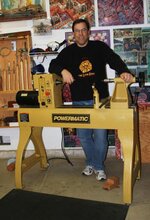Long response
I have 4 lathes in my shop and soon to get another, Only one has an RPM indicator, it and one other have reeves drives so the speed is reasonably consistent, to the lock in positions on the face below the lever. The Shop Fox which is almost a good lathe is the one with a Tach. It doesn't agree with the indicated speeds buy the speed lever, I find that I can feel when the wood is cutting at a safe optimum, given that this is on a 16x42 inch lathe I find that 600 RPM can be too fast, and this is a heavy lathe, it's all Cast Iron including the base. I don't know of any wood species that has a surface foot per minute spec. in machine tool technology we designated wood and plastic to have a SFPM (Surface Feet Per Minute) factor of 200, with cold rolled or 10-18 steel to have a coefficient of 60 to 70 and tool steels down to 25 to 30. aluminum were in the 100 range Carbide and some other exotics got down into the low teens and required Diamond cutting bits and mills, so this should give you an idea of the spread of materials in regards to their machineability and turning is just another form of machining, More fun but a little easier and that turning a hundred or two or even three will cause catastrophic failure.
If the wood is balanced, the tools are sharp the operator in control, and not being brazenly ignorant of his surroundings, Crank it up!!! But on the other hand there are times when 90 RPM may be frightfully fast
Common sense must prevail, just because some wood guru has said the a piece of this or that can be best turned at 1250 RPM.Balderdash I say!!
OK what is the gross weight of the piece of timber, How wet is it, how are you securing the work piece to the machine, if a person is going to turn wood they need to be comfortable, not worrying about how fast the lathe is spinning, I feel it's far more important to concentrate on keeping tools sharp working as swiftly and safely as possible.
On Metals there is a given formula for all qualities and grades of Steel brass Bronze and different alloys of all ferrous and non ferrous metals, stipulating how fast or at what SFPM the metal can be removed,. well as how many surface feet per minute can be safely and expediently removed and a good finish provided , if the tools are properly shaped and sharpened. This is also up for grabs when things like the cutter material the coating of the tool and what type or lack of cooling is used.
but there is still a general rule based on these things,
Man enjoy the lathe Tachometers are available and should be through Powermatic, but best advice from an old man the builds machines and tools is "Work with in the envelope that you feel comfortable", later when you and your machine get to know each other, see if the machine feels better up a hundred or so . if not then drop back to YOUR comfort zone.
As an anecdotal note I saw a video done by a guy using a tool similar to my Woodchuck Bowl Pro, I'm not sure but it looked like a big Oneway Lathe, any way this guy is doing the inside of a bowl using a square insert and is really leaning on the tool, a pretty good size guy and he was exerting a good bit of pressure inwards on the tool, it was about a 12 or 14 inch bowl, and I'd guess he was turning around 1600 to 1800 RPM. I had never saw such a shower of shavings come out of a bowl like that.
OK I had to try my tool, My Woodchuck tool is virtually identical except for the stamped logo.
I was on the back end of the lathe, the tail stock was off and it was a 15 inch piece of Osage Orange I was on a 3520 and honking along showering a yellow blizzard when all of a sudden I hit an inside void in the bowl about 4-1/2 to 5 inches in,and about 5-3/4 or more over the tool rest , I couldn't get to the head stock to shut it off and I was holding on for dear life, I weigh 260 and I swear I thought I was going over the headstock, fortunately my friend finally opened his eyes and saw the problem, and shut the lathe off.
You mat be wondering how this answers or even gets near your question , there is one thing that rpm TABLES FOR WOOD can not compensate for and that is plain Ignorance an stupidity, or the type and condition of the tool being used, the wood will tell you where it want's to be cut.
Respectfully
Ken Ferrell

